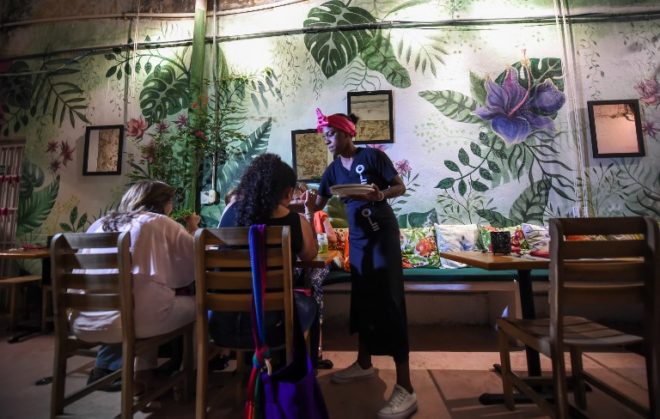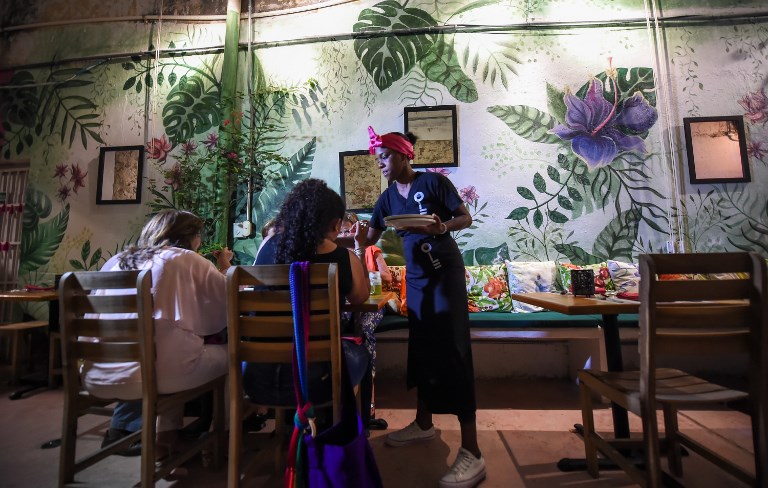
Arleth Martinez smooths her clothes, kisses a photo of her twins and leaves for work. It’s only a few meters from her Colombian cell to her unusually fragrant workplace, South America’s first gastronomic prison restaurant.
Following the example of South Africa’s Pollsmoor Prison, where Nelson Mandela wound down his 27-year sentence, and another in Milan, inmates at the teeming women’s prison in downtown Cartagena are getting a taste for reintegration back into society with an experience that mixes cuisine with customer service.
The photo of the seven-year-old twins is Arleth’s “lucky charm” — a constant reminder of the future.
Sentenced to six years for extortion in 2015, present-day life in the San Diego prison has become a little more palatable since she started working at the restaurant late last year.
“Even though I’m still in prison, I feel free because it’s a completely different environment,” said the 26-year-old, wearing a pristine black t-shirt and apron, her hair gathered in a colorful pink turban. At least around the restaurant “you don’t see so many bars”.
Fifteen of the 150 inmates, most of them accused of murder or drug trafficking, work either in the kitchen, or in table service. The work is incentivised — two days washing dishes, preparing or serving food, gets a day of prison time reduced.
A second chance
A fuchsia curtain separates the 50-seat restaurant from the cells. A mural of flowers painted by the inmates provides some colorful relief from the drab prison surroundings.
Named “El Interno,” which roughly translates as “The Intern,” the eatery provides a little extra frisson for curious locals and tourists while they enjoy a 30-dollar menu that runs from “fish ceviche in coconut milk” to “rice with seafood” and “posta Cartagenera” — meat in black sauce typical of the city.
“When they arrive, people know that they are entering a prison, and that they will be served by prisoners,” said Johana Bahamon, a Colombian television actress whose Accion Interna (Internal Action) Foundation was the driving force behind the idea.
“When they leave, they are happy to have met talented, courageous and real human beings,” Bahamon told AFP.
El Interno is a rare opportunity for inmates in a country that has the largest prison population in South America after Brazil.
In the last 17 years, the number of those behind bars in Colombia has more than doubled from 51,500 to 119,000, according to the International Committee of the Red Cross (ICRC).
Tougher sentences and an increase in convictions for drug trafficking have filled Colombia’s 138 prisons to well beyond their combined 80,000 capacity.
Bahamon believes that women in these overcrowded prisons badly need to be offered a fresh start.
It’s a recurring theme at the restaurant.
“Yo creo en las segundas oportunidades” (I believe in second chances) is emblazoned on Arleth’s black T-shirt and inscribed on the signs on the walls pointing to the colorful eatery.
Bahamon said she was inspired by InGalera, a public restaurant run by Italian prisoners which set up in the parking lot of a Milan prison a few years ago.
She convinced the authorities to adapt the concept to the San Diego prison, located right in the tourist heart of Cartagena, a few meters from the luxurious hotels that abound around the old Colonial city’s historic port.
For well-to-do customers like Antonio Galan, from the capital Bogota, “everything has a flavor and aroma of freedom, from the taste of the dishes to the ambiance of the restaurant.”
25 to a cell
Thus, in the evenings at least, Arleth is surrounded by well-heeled influencers, personalities and media officials, who stand in solidarity with the cause.
El Interno offers gourmet dinners from Tuesday to Sunday. But when it closes at 11:00 pm, it’s back to the mundane reality of answering roll call in their prison cells for Arleth and her fellow inmates.
Like other prisons in Colombia, San Diego is overcrowded. Some 150 women, many of whom are awaiting trial, share a space designed for just 100.
When she came to San Diego, Arleth said she got the shock of her life, as she had to come to terms with the prison drug abuse, poor hygiene, and a dilapidated building.
For four months she slept on the floor, 25 to a cell. She was anxious for her children, entrusted to their grandmother. Their father, she says, mistreated and abandoned his family.
But last year she passed her secondary school exams and trained as a waitress in the prison. Her work at the restaurant has earned her the right to a rare luxury here — a bunk in a cell.
In prison, “only warriors” survive, she said.















































